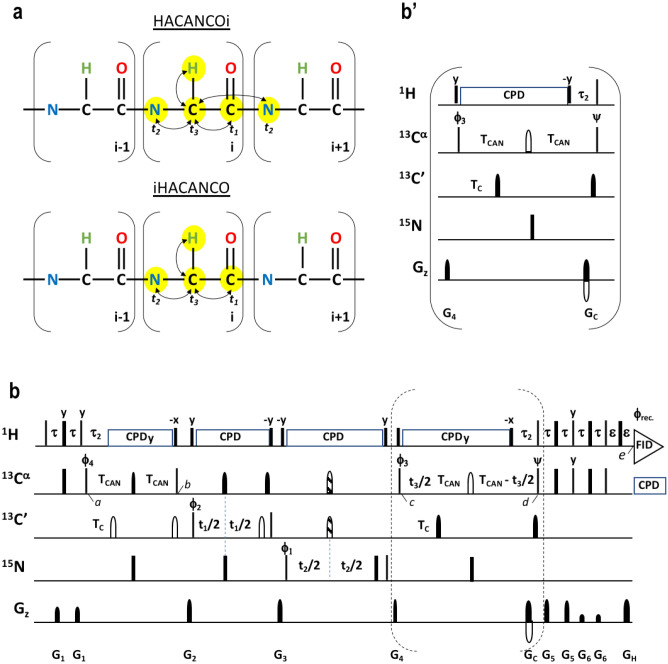Fig. 1.
Description of the HACANCOi experiment. a Schematic presentation of magnetization transfer pathway during the proposed 4D HACANCOi experiment and 4D iHACANCO scheme (Mäntylahti et al. 2010; Tossavainen et al. 2020). Black arrows indicate the so-called out-and-back transfer pathway from 1Hα(i) to 13Cα(i) and further to 13C′(i) and 15N(i)/15N(i + 1). b 4D HACANCOi experiment to correlate 1Hα(i), 13Cα(i), 13C′(i) and 15N(i)/15N(i + 1) chemical shifts. Inset b′ 3D HA(CA)NCOi experiment to correlate 1Hα(i), 13C′(i) and 15N(i)/15N(i + 1) chemical shifts. Narrow and wide filled bars on 1H and 15N channels correspond to rectangular 90° and 180° pulses, respectively, applied with phase x unless otherwise stated. All 13C pulses are band-selective shaped pulses, denoted by filled narrow bars (90°) and filled and unfilled half ellipsoids (180°). Pulses denoted with unfilled bars are applied on-resonance. The 1H, 15N, 13C′, and 13Cα carrier positions are 4.7 (water), 121 (center of 15N spectral region), 174 ppm (center of 13C′ spectral region), and 54 ppm (center of 13Cα spectral region). The 13C carrier is initially set to the middle of 13C′ region (174 ppm), and shifted to 13Cα region (54 ppm) prior to 90° 15N pulse ϕ3. All band-selective 90° and 180° pulses for 13Cα (54 ppm) and 13C′ (174 ppm) have the shape of Q5 and Q3 (Emsley and Bodenhausen 1992) and duration of 240.0 μs and 192.0 μs at 800 MHz, respectively. The adiabatic 180° Chirp broadband inversion pulse, denoted with striped half ellipsoid in both 13C channels, for inverting 13Cα and 13C′ magnetization in the middle of t2 period had duration of 500 μs at 800 MHz (Böhlen and Bodenhausen 1993). The Waltz-65 sequence (Zhou et al. 2007) with strength of 4.17 kHz was employed to decouple 1H spins. The GARP (Shaka et al. 1985, 1987) with field strength of 4.55 kHz was used to decouple 13C during acquisition. Delay durations: τ = 1/(4JHC) ~ 1.7 ms; τ2 = 3.4 ms (optimized for non-glycine residues) or 2.2–2.6 ms (for observing both glycine and non-glycine residues); ε = duration of GH + field recovery ~ 1.2 ms; 2TC = 1/(2JCαC’) ~ 9.5 ms; 2TCAN ~ 28 ms. Maximum t3 is restrained t3,max < 2.0*(TCAN–τ2). Frequency discrimination in 13C′ and 15N dimensions is obtained using the States-TPPI protocol (Marion et al. 1989) applied to ϕ1 and ϕ2, respectively, whereas the quadrature detection in 13Cα dimension is obtained using the sensitivity-enhanced gradient selection (Kay et al. 1992; Schleucher et al. 1994). The echo and antiecho signals in 13Cα dimension are collected separately by inverting the sign of the GC gradient pulse together with the inversion of ψ, respectively. Phase cycling: ϕ1 = x, − x; ϕ2 = 2(x), 2(− x); ϕ3 = 4(y), 4(− y); ϕ4 = y; ψ = x; rec. = x, 2(− x), x, − x, 2(x), − x. Gradient strengths (% of max G/cm) and durations (ms): G1 = 17%, 0.234 ms; G2 = 40%, 1.0 ms; G3 = 60%, 1.0 ms; G4 = 25%, 1.0 ms; G5 = 35.7%, 0.234 ms; G6 = 7.1%, 0.234 ms; GC = 80.0%, 1.0 ms; GH = 20.1% 1.0 ms. The pulse sequences’ code and parameter file for Bruker Avance system are available from authors upon request

